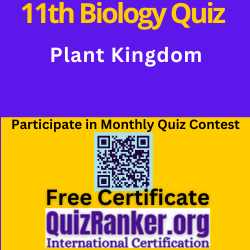Test your knowledge of the Plant Kingdom MCQ Test with our 11th Biology Chapter 3 MCQ Test. Learn about different plant types, structures, and life cycles through this easy-to-use Plant Kingdom MCQ Test.
Attempt Plant Kingdom MCQ Test
Attempt Chapter wise 11th biology MCQ Test and Monthly Quiz contest of Biology 11th grade.
Check Chapterwise 11th Biology MCQ
Chapter 1 The Living World MCQ Test
Chapter 2 Biological Classification MCQ Test
Chapter 4 Animal Kingdom MCQ Test
Chapter 5 Morphology of Flowering Plants MCQ Test
Chapter 6 Anatomy of Flowering Plants MCQ Test
Chapter 7 Structural Organisation in Animals MCQ Test
Chapter 8 Cell The Unit of Life MCQ Test
Chapter 9 Biomolecules MCQ Test
Chapter 10 Cell Cycle and Cell Division MCQ Test
Chapter 11 Photosynthesis in Higher Plants MCQ Test
Chapter 12 Respiration in Plants MCQ Test
Chapter 13 Plant Growth and Development MCQ Test
Chapter 14 Breathing and Exchange of Gases MCQ Test
Chapter 15 Body Fluids and Circulation MCQ Test
Chapter 16 Excretory Products and their Elimination MCQ Test
Chapter 17 Locomotion and Movement MCQ Test
Chapter 18 Neural Control and Coordination MCQ Test
Chapter 19 Chemical Coordination and Integration MCQ Test
Brief Summary
The plant kingdom includes algae, bryophytes, pteridophytes, gymnosperms, and angiosperms.
- Algae are simple, aquatic, chlorophyll-bearing organisms that can reproduce by fragmentation, spores, or gametes. They are classified into Chlorophyceae, Phaeophyceae, and Rhodophyceae based on their pigments and stored food.
- Bryophytes can live on land but need water for reproduction. They have structures resembling roots, stems, and leaves and are divided into liverworts and mosses. The main plant body (gametophyte) produces gametes, which form a zygote and then a sporophyte, producing spores that grow into new gametophytes.
- Pteridophytes have true roots, stems, and leaves with vascular tissues. The main plant (sporophyte) produces spores that grow into gametophytes, which need cool, damp places. These gametophytes produce gametes, forming a zygote that develops into a new sporophyte.
- Gymnosperms have exposed seeds (naked-seeded plants) because their ovules are not enclosed by an ovary wall. They produce microspores and megaspores in cones. The pollen tube releases male gametes to fertilize the egg cell, forming a zygote that develops into a seed.
- Angiosperms are flowering plants divided into two classes: dicotyledons and monocotyledons
Source for Study
Total Views: 22


